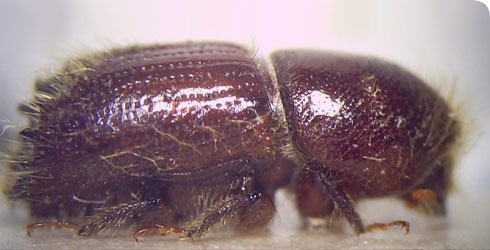Biology
The beetle introduces a fungus, Ceratocystis polonica - the blue-stain fungus - to the tree, which interferes with the tree’s resin production. Without this resin the tree is unable to repel potential beetle pest attack. This is why it is more advantageous to the beetle to attack damaged or dying wood. When the beetle is forced to attack live stands, its population must be larger in number to introduce enough fungus to attack a living tree, which under normal circumstances, would be able to produce enough defensive resin to fend off the attack. This is achieved by the aggregation pheromone produced by the males, (methyl butenol and cis-verbenol) though females can produce some cis-verbenol.
The pheromone is also used to attract mates. The male usually enjoys a harem of up to 4 females. The male prepares a ‘nuptial chamber’ beneath the bark to make way for the female to excavate larval tunnels, along which she will lay her eggs. This is a linear ‘gallery’ of chambers which increase in size as the larvae grow bigger. The tunnels radiate at right-angles from the central chamber and reach between 10cm to 20cm in length. They are usually 3-armed but can also be multi-branched.
These tunnels are excavated in the phloem layer which is 2–4mm thick. The phloem transports sugars and amino acids throughout the tree, providing nutrition for root development and needle growth.
The male regulates the number of females by blocking the entrance hole with his spiny rear end. This ensures there is no adverse competition amongst the larvae and also prevents other pest attacks on the vulnerable soft-bodied larvae.
The female lives for approximately 3 weeks in which time she is capable of laying approximately 50 eggs. Egg production is temperature-dependant, with the low threshold at approximately 11°C. For juvenile development, optimum temperature is approximately 30°C.
This beetle’s life-cycle from reproduction to adulthood (full metamorphosis) is completed between 7–11 weeks.
A key to its success is its ability to complete more than one generation per year, dependant on favourable temperature.
